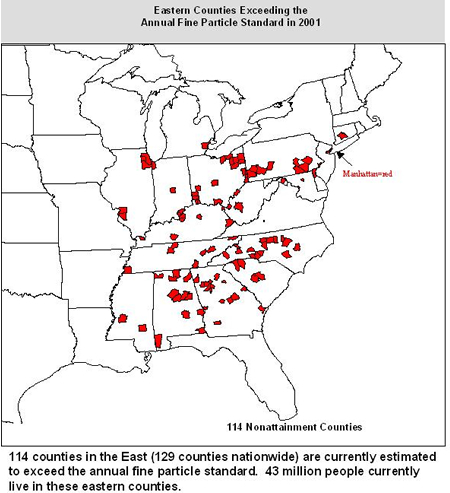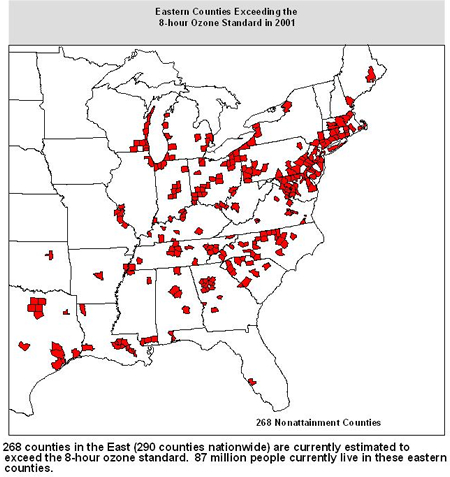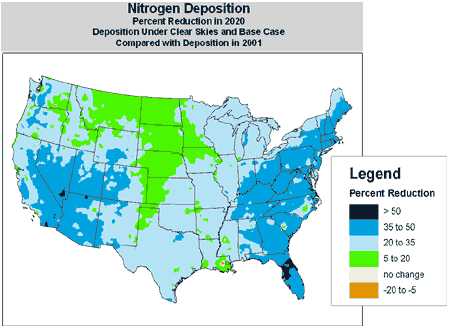Clear Skies
Health and Environmental Benefits
Clear Skies would protect public health and the environment by improving air quality, decreasing exposure to fine particles and ozone, and reducing deposition of sulfur, nitrogen, and mercury. In 2010, early reductions in fine particle and ozone levels under Clear Skies would result in 7,800 fewer premature deaths and $55 billion in annual health and visibility benefits nationwide each year. Under Clear Skies, each year, by 2020, Americans would experience approximately:
The monetized benefits of Clear Skies would total approximately $113 billion annually by 2020, substantially outweighing the annual costs of $6.3 billion. This includes:
This does not include the many additional benefits that cannot currently be quantified but are expected to be significant, including the health benefits associated with reduced exposure to mercury and ecological benefits associated with reductions in acid rain and coastal eutrophication. Clear Skies would help states meet the National Ambient Air Quality Standards (NAAQS). By 2020, based on initial modeling, Clear Skies is expected to:
|
|
Detailed Benefits Information
Section
B of the 2003 Clear Skies Technical Package (PDF, 49 pp.,
4.6MB)
This document features an in-depth analysis of the expected benefits of Clear
Skies. It includes maps and information on the improvements in human health
and the environment that would be achieved with Clear Skies. This document
also includes monetized benefits.
Technical Addendum: Methodologies for
the Benefit Analysis of the Clear Skies Act of 2003 (PDF,
86 pp.,1.7MB)
This document details the methods used to analyze the benefits of the Clear
Skies Act of 2003 and presents the results of the analysis. It quantifies the
health and visibility improvements that would be achieved by Clear Skies and
projects the monetary value of those improvements.
Overview of the Human
Health and Environmental Effects of Power Generation: Focus on Sulfur
Dioxide (SO2), Nitrogen Oxides (NOx) and Mercury (Hg) (PDF,
15 pp., 1.1MB)
Clear Skies is intended to reduce the health and environmental impacts of power
generation. This document summarizes the effects of power generation, particularly
those associated with sulfur dioxide (SO2), nitrogen oxides (NOx), and mercury.
This document does not address the specific benefits of Clear Skies.
Related Environmental and Health Information
Emissions Cap-and-Trade
and Hot Spots (PDF, 17pp., 17.3MB)
1The two sets of estimates reflect alternative assumptions and analytical approaches regarding quantifying and evaluating the effects of airborne particles on public health. All estimates assume that particles are causally associated with health effects, and that all components have the same toxicity. Linear concentration-response relationships between PM and all health effects are assumed, indicating that reductions in PM have the same impact on health outcomes regardless of the absolute level of PM in a given location. The base estimate relies on estimates of the potential cumulative effect of long-term exposure to particles, while the alternative estimate presumes that PM effects are limited to those that accumulate over much shorter time periods. All such estimates are subject to a number of assumptions and uncertainties. It is of note that, based on recent preliminary findings from the Health Effects Institute, the magnitude of mortality from short-term exposure (alternative estimates) and hospital/ER admissions estimates (both estimates) may be overstated. The alternatives also use different approaches to value health effects damages. The key assumptions, uncertainties, and valuation methodologies underlying the approaches used to produce these results are detailed in Technical Addendum: Methodologies for Benefit Analysis of the Clear Skies Initiative, 2003. (PDF, 86 pp., 1.7MB)
2 This analysis shows the counties that would come into attainment due to Clear Skies alone in 2020. Additional federal and state programs are designed to bring all counties into attainment by 2017 at the latest. Clear Skies is not expected to bring additional counties into attainment for 2020 in the West. Therefore, the Western region is not presented here.






